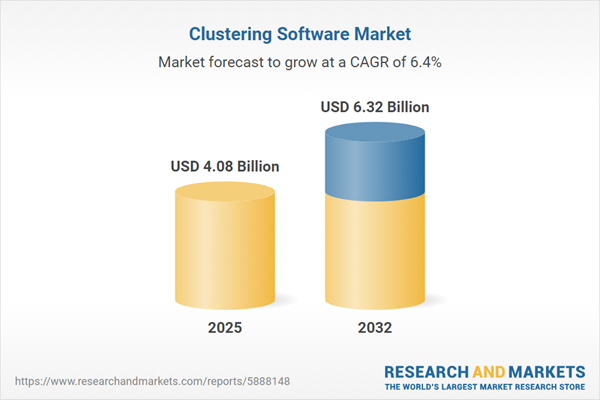Speak directly to the analyst to clarify any post sales queries you may have.
Clustering software is driving enterprise analytics, offering advanced capabilities for organizations to transform data complexity into actionable business intelligence. As adoption accelerates, its role in supporting data-driven decisions and strategic agility grows significantly across diverse industries.
Market Snapshot: Clustering Software Market Size and Growth
The global clustering software market is experiencing steady growth as enterprises invest in digital transformation. In 2024, the market reached USD 3.84 billion, and it is forecast to rise to USD 4.08 billion by 2025, reflecting a compound annual growth rate (CAGR) of 6.42%. Projections through 2032 suggest continued momentum, culminating in a market value of USD 6.32 billion. Key factors driving this trend include the integration of artificial intelligence, increased demand for cloud-native analytics platforms, and the strategic focus on data-centric business models. This expansion underscores the importance of clustering software as a foundation for adaptive data strategies in evolving business environments.
Scope & Segmentation of Clustering Software
- Components: Both standalone clustering tools and integrated analytics platforms are available, complemented by hosted deployment, consulting, and support services that cater to different organizational maturity levels.
- Deployment Modes: Solutions are offered via on-premises, private cloud, and public cloud models to align with unique requirements around data security, compliance, and scalability.
- Clustering Algorithm Types: Supported algorithms include density-based, partitioning, hierarchical, grid-based, and model-based approaches, enabling tasks such as customer segmentation, predictive analytics, and continuous monitoring.
- Organization Sizes: Product offerings scale to fit large enterprises, mid-sized firms, and small organizations, ensuring seamless adoption regardless of analytics sophistication or workflow complexity.
- Industry Verticals: Clustering software serves industries such as banking, financial services, insurance, healthcare, information technology, telecommunications, and retail, delivering functions like risk management, fraud detection, cohort analysis, and inventory optimization.
- Geographical Coverage: Adoption is active in the Americas, EMEA, and Asia-Pacific regions, shaped by local compliance needs, digital readiness, and data management expectations that drive tailored deployment strategies.
- Key Companies: Leading vendors, including Microsoft, Amazon Web Services, Google, IBM, SAS, Oracle, SAP, Alteryx, TIBCO, and Teradata, provide scalable, robust clustering features for today’s evolving enterprise analytics requirements.
Key Takeaways for Senior Decision-Makers
- Clustering software efficiently transforms organizational data into intelligence, supporting strategic alignment and rapid response to market changes.
- Diverse deployment options empower organizations to address regulatory and security demands, facilitating consistent global operations and effective scalability.
- Integrating artificial intelligence and machine learning with clustering platforms reduces manual analysis and accelerates operational insights, improving decision cycles.
- Flexibility between open-source and proprietary clustering platforms supports continuous adaptation to changing business processes and compliance needs.
- Adopting cloud-centric solutions allows organizations to extend analytics seamlessly as digital transformation initiatives mature, providing a scalable foundation for evolving needs.
- Comprehensive clustering functions enable focused risk evaluation, enable precise customer segmentation, and support targeted resource deployment, contributing to long-term organizational resilience.
Tariff Impact on Clustering Software Supply Chains
Recent U.S. tariffs have increased hardware costs for critical infrastructure, affecting clustering software environments reliant on in-house processing. As a result, more organizations are shifting to cloud-based clustering models for greater cost stability and flexibility. Strategic partnerships between software providers and hardware vendors are becoming essential to manage supply chain risks and adapt to ongoing trade changes.
Methodology & Data Sources
This analysis draws on input from software architects, data scientists, and enterprise leaders, combined with research by recognized technology intelligence sources. The approach ensures coverage of adoption patterns, practical deployment, and the strategic outlook for clustering software within enterprise settings.
Why This Report Matters
- Enables executive teams to connect clustering software strategy with digital transformation and continuity planning, positioning organizations to quickly adapt to operational challenges.
- Clarifies adoption drivers and inhibitors across regions, technologies, and regulatory environments, helping to optimize compliance strategies and guide sector-wide decisions.
- Equips stakeholders to anticipate market and policy shifts, supporting timely, data-based investment decisions in evolving digital landscapes.
Conclusion
Clustering software is central to turning complex datasets into business value. Strategic investment ensures that organizations remain agile and ready for ongoing digital advancement.
Additional Product Information:
- Purchase of this report includes 1 year online access with quarterly updates.
- This report can be updated on request. Please contact our Customer Experience team using the Ask a Question widget on our website.
Table of Contents
3. Executive Summary
4. Market Overview
7. Cumulative Impact of Artificial Intelligence 2025
Companies Mentioned
The companies profiled in this Clustering Software market report include:- Microsoft Corporation
- Amazon Web Services, Inc.
- Google LLC
- International Business Machines Corporation
- SAS Institute Inc.
- Oracle Corporation
- SAP SE
- Alteryx, Inc.
- TIBCO Software Inc.
- Teradata Corporation
Table Information
| Report Attribute | Details |
|---|---|
| No. of Pages | 195 |
| Published | October 2025 |
| Forecast Period | 2025 - 2032 |
| Estimated Market Value ( USD | $ 4.08 Billion |
| Forecasted Market Value ( USD | $ 6.32 Billion |
| Compound Annual Growth Rate | 6.4% |
| Regions Covered | Global |
| No. of Companies Mentioned | 11 |









